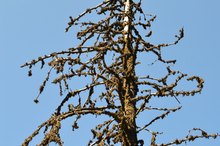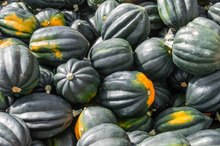List of Diseases in Plants Caused by Viruses
Some of the same types of viruses that infect humans can also infect plants. Plants and humans do not transmit viruses to each other, but humans can spread plant viruses through physical contact 1. Most frequently, plants catch a cold when an insect or other small animal invades the cellulose armor that protects them from the environment. Viruses also spread through infected seeds, grafting, wind, splashing, pollination and dripping sap. Unlike humans, plants never recover from a virus.
If you are experiencing serious medical symptoms, seek emergency treatment immediately.
Tobacco Mosaic Virus
The first plant virus discovered, tobacco mosaic virus (TMV), attacks members of the nightshade, or solanaceae, family. These include:
- tobacco
- pepper
- potato
- tomato
- eggplant
- cucumber
- petunia
The virus spreads through entry into breaks of cell walls caused by insects or other physical damage. It has another claim to fame as the first virus imaged with an electron microscope.
Cucumber Mosaic Virus
The Effects of Air Pollution on Plants
Learn More
Aphids spread it, and they cause physical damage to the plant, which allows entry of the virus via wind, splashing or dripping sap. The virus causes twisting in young leaves. That stunts growth of the entire plant and causes poor fruit or leaf production.
- Aphids spread it, and they cause physical damage to the plant, which allows entry of the virus via wind, splashing or dripping sap.
- That stunts growth of the entire plant and causes poor fruit or leaf production.
Barley Yellow Dwarf
The barley yellow dwarf virus infects several grains and staple crops, including wheat. Aphids primarily spread the virus. The virus causes discoloration of leaves and the tips of the plants, which reduces photosynthesis, stunts growth and decreases production of seed grains.
Bud Blight
The Effects of Vitamins on Plant Growth
Learn More
The bud blight virus infects soybeans, a staple crop. It causes the stem to bend at the top and the buds to turn brown and drop off the plant. Nematodes spread this virus.
Sugarcane Mosaic Virus
The sugarcane mosaic virus discolors leaves of the sugarcane plant, restricting its ability to feed itself through photosynthesis and grow. It stunts the growth of young plants. Aphids and infected seed spread the virus.
Cauliflower Mosaic Virus
The cauliflower mosaic virus infects members of the brassica, or mustard, family, which includes cabbage, brussels sprouts, cauliflower, broccoli and rape seed.include:
- The cauliflower mosaic virus infects members of the brassica
- or mustard
- family
- which includes cabbage
- brussels sprouts
- cauliflower
- broccoli
- rape seed
It causes a mosaic or mottle on the leaves, which stunts growth. Aphids and mechanical exposure spread the virus.
Lettuce Mosaic Virus
The lettuce mosaic virus mottles the leaves of almost all types of lettuce, stunting its growth and eliminating its market appeal. Aphids and infected seeds spread the virus.
Maise Mosaic Virus
The maise mosaic virus causes yellow spots and stripes on the leaves of corn, stunting its growth. Leafhoppers spread the virus.
Peanut Stunt Virus
The peanut stunt virus causes discoloration and distortion of the leaves of peanuts and some other rhizomes, stunting their growth. Aphids and sap spread the virus.
Related Articles
References
- Zheng HC, Yan L, Cui L, Guan YF, Takano Y. Mapping the history and current situation of research on John Cunningham virus - a bibliometric analysis. BMC Infect Dis. 2009;9:28. doi:10.1186/1471-2334-9-28
- Padgett BL, Rogers CM, Walker DL. JC virus, a human polyomavirus associated with progressive multifocal leukoencephalopathy: additional biological characteristics and antigenic relationships. Infection and Immunity. 1977;15(2):656-662.
- T Kunitake, T Kitamura, J Guo, F Taguchi, K Kawabe, Y Yogo. Parent-to-child transmission is relatively common in the spread of the human polyomavirus JC virus. Journal of Clinical Microbiology. 1995;33(6):1448-1451.
- Moti L. Chapagain, Vivek R. Nerurkar, Human Polyomavirus JC (JCV) Infection of Human B Lymphocytes: A Possible Mechanism for JCV Transmigration across the Blood-Brain Barrier, The Journal of Infectious Diseases. 2010 July;202(2):184–191. doi:10.1086/653823
- Multiple Sclerosis Trust. JC virus and PML. MS Trust, A-Z. Updated 2018.
- Lazrek, M. Infection with polyomavirus JC: Is highly prevalent, and can be fatal in immunocompromised people. BMJ: British Medical Journal. 2011;343(7823), 548-548.
- Multiple Sclerosis Trust. JC virus and PML. MS Trust, A-Z. Updated 2018.
- Zheng HC, Yan L, Cui L, Guan YF, Takano Y. Mapping the history and current situation of research on John Cunningham virus - a bibliometric analysis. BMC Infect Dis. 2009;9:28. doi:10.1186/1471-2334-9-28
Writer Bio
Charles Mathewson is a freelance writer residing in Plymouth, Mass. He worked as a newspaper reporter and editor beginning in 1988 for "Memorial Press Group" in Plymouth, Mass. and the "Brockton Enterprise." He has also published on Patch.com. Mathewson earned a Bachelor of Arts degree from Goddard College. He was selected to participate in the Nieman Seminar for Narrative Editors at Harvard University.









